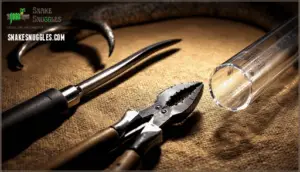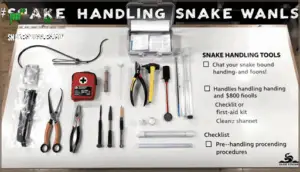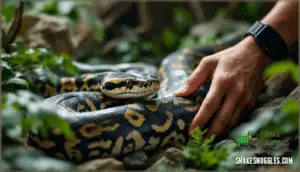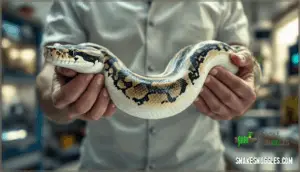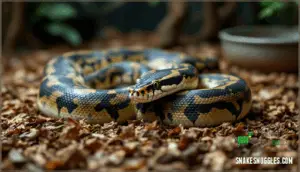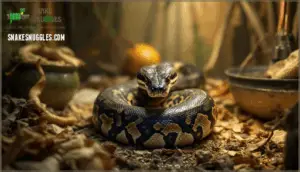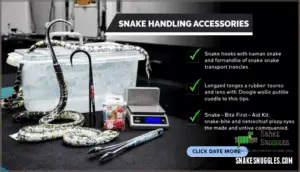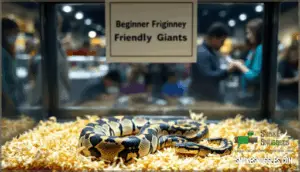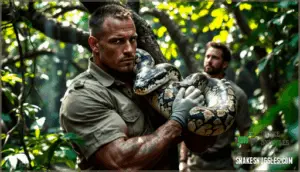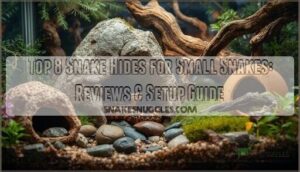This site is supported by our readers. We may earn a commission, at no cost to you, if you purchase through links.

Most accidents happen because keepers underestimate the strength of large constrictors or miss early warning signs of stress. The difference between safe snake interaction for large snakes and a trip to the emergency room often comes down to preparation and technique.
You need the right gear, a solid understanding of snake behavior, and protocols that account for their sheer power. This guide covers the equipment, methods, and safety measures that keep both keepers and snakes secure during every interaction.
Table Of Contents
- Key Takeaways
- Handling Large Snakes Safely
- Choosing The Right Equipment
- Preparing for Large Snake Handling
- Safe Handling Techniques for Large Snakes
- Managing Large Snake Behavior
- Essential Safety Precautions
- Large Snake Handling Accessories
- Choosing The Right Large Snake Species
- Advanced Large Snake Handling Techniques
- Emergency Response and First Aid
- Frequently Asked Questions (FAQs)
- How to handle snakes safely?
- How do you support a large snake?
- How to master snake handling techniques?
- How do you handle a large constrictor snake?
- What equipment do you need to handle a snake?
- How to handle large snakes?
- What kind of snakes do snake handling churches use?
- How to handle aggressive snakes?
- How do you get rid of big snakes?
- What experience is needed to handle large snakes?
- Conclusion
Key Takeaways
- Large constrictors over 8 feet require at least one handler per 8 feet of snake length because their strength can overpower a solo keeper during defensive coiling or constriction.
- Most accidents happen when keepers miss early warning signs like hissing, tight coiling, or S-curve posturing—reading these stress signals before they escalate prevents bites and injuries.
- Proper body support means distributing the snake’s weight evenly across multiple contact points every 2-3 feet to prevent spinal injury and reduce the risk of defensive constriction.
- Essential safety gear includes species-appropriate hooks and tongs, puncture-resistant gloves, and a stocked first aid kit with a pre-planned emergency response protocol including hospital contacts.
Handling Large Snakes Safely
Working with large snakes isn’t something you can wing. You need the right gear, solid techniques, and a clear plan if things go sideways.
Here’s what you need to know to stay safe and keep your snake calm.
Essential Equipment and Gear
When you’re interacting with a snake that could wrap around you like a heavyweight wrestler, the right gear isn’t optional—it’s your lifeline. You’ll need sturdy snake tools like hooks and tongs sized for your animal. Protective gear includes thick gloves—leather or puncture-resistant materials work best.
Always inspect and maintain equipment before each use. Proper gear storage extends tool life. Budget options exist, but never skimp on essential tools and safety gear when interacting with large snakes.
Approach and Handling Techniques
Once you’ve got the right tools in hand, the way you move and read your snake makes all the difference between a safe session and a potential wreck. Approach slowly and watch for coiling or hissing—key stress signals.
Use controlled movements while supporting the body weight evenly across your arms. A secure grip means gentle but firm contact.
When interacting with large snakes with a partner, clear staff communication prevents mishaps. These animal care practices keep both you and your animal calm throughout the session.
Safety Precautions and Emergency Response
Even with smooth technique on your side, a single lapse in preparation can turn a routine session into a crisis that demands quick thinking. Keep your first aid kit stocked and close by. Know your bite emergency plan before trouble hits—locate the nearest hospital and save those numbers.
Professional training builds safe interaction knowledge you can’t skip. Watch for snake bite symptoms like swelling or pain, then start emergency response fast.
Antivenom storage requires proper temperature control if you’re interacting with large snakes regularly.
Choosing The Right Equipment
Having the right gear isn’t just about convenience—it’s the difference between secure control and a trip to the emergency room. Large snakes demand specialized tools that match their size and strength.
Let’s look at the three key pieces of equipment you’ll need before you even think about picking up a big snake.
Snake Hooks and Tongs
When a large snake needs moving, your hands shouldn’t be the first thing making contact. Snake hooks and snake tongs give you control while keeping a safe distance. Choose snake tools based on the animal’s size—longer tong length works better for bigger constrictors.
Look for sturdy hook material like stainless steel and good grip strength. Safety latches prevent accidental releases.
Regular maintenance tips include checking for damage and cleaning after each use. Using snake tools properly means choosing snake hooks that match your specific needs.
Snake Handling Gloves
You don’t need leather work gloves from the hardware store—snake restraint gloves are built different. Look for these features when restraining large snakes:
- Glove material – Heavy-duty leather or Kevlar blocks fangs
- Bite resistance – Multi-layer protection stops punctures
- Dexterity levels – You need grip without bulk
- Glove length – Extended cuffs protect forearms
Proper fit matters. Loose gloves slip during restraint. Snug protective clothing and safety gear keep you safe without restricting movement.
Snake Enclosures and Containers
A flimsy tank is like a ticking time bomb—your large snake will find the weak spot and exploit it. Choose enclosures with strong material safety—PVC or HDPE outperforms glass for large snakes. Security features matter: locking mechanisms prevent escapes. Proper enclosure size allows natural movement patterns while temperature control maintains thermal gradients.
| Feature | Minimum Standard | Why It Matters |
|---|---|---|
| Enclosure Size | Length = 2/3 snake size | Movement reduces stress |
| Security Features | Locking latches + clips | Prevents dangerous escapes |
| Material Safety | PVC, HDPE, or reinforced | Withstands constrictor pressure |
Follow cleaning protocols weekly—sanitize without harsh chemicals that damage materials or harm your snake’s respiratory system.
Preparing for Large Snake Handling
Before you pick up a large snake, you need to get yourself and your space ready. The right prep work keeps both you and the snake safe during interaction.
Here’s what you need to do before you pick up that python or boa.
Wearing Protective Gear
Think of protective gear as your armor in the snake arena—without it, you’re leaving yourself open to unnecessary risk. Working with large snakes demands protective clothing that shields your skin from bites and scratches. Your gear must fit properly to prevent fumbling during critical moments.
Essential protective gear:
- Thick gloves: Choose puncture-resistant glove material designed for snake handling.
- Full clothing coverage: Wear long sleeves, sturdy pants, and high-top boots.
- Gear maintenance: Check for holes or worn spots before each use.
Keep extra protection on hand for personal safety.
Sanitizing Hands and Equipment
Clean hands and tools aren’t just about hygiene—they’re your first defense against triggering a feeding response or spreading disease. Wash your hands with warm water and antiseptic handwash for at least 20 seconds before interaction sessions.
Wipe down hooks and tongs with safe solutions after each use. Equipment disinfection prevents transmission of bacteria between snakes.
Hand sanitizer works in a pinch, but washing hands after interaction remains the best practice for safe snake interaction.
Creating a Safe Environment
Your space for working with snakes can make or break a safe interaction—get it wrong, and you’re inviting chaos. Clear protocols and risk assessment protect both you and the snake. Choose a quiet environment with secure enclosures and emergency access routes.
Key elements for safe snake interaction:
- Remove obstacles that could trip you or block exits
- Lock doors to prevent interruptions during large snakes interaction
- Check lighting so you can spot stress signals clearly
- Stage safety precautions like first aid kits within reach
Knowing When to Handle Snakes
Timing separates cautious keepers from those rushing into trouble—and large snakes don’t forgive poor judgment. Safe snake care depends on reading environmental factors and digestive state before sessions begin.
Skip care during:
- Shedding Cycle: Cloudy eyes and dull skin signal stress
- Post-Feeding: Wait 48-72 hours for digestion
- Aggressive Displays: Hissing or striking means back off
- Health Issues: Lethargy or breathing problems need evaluation
- High Activity: Nighttime restlessness disrupts frequency
Snake behavior and temperament guide every decision when interacting with large snakes.
Safe Handling Techniques for Large Snakes
Working with a large snake isn’t something you can rush into without a plan. The right approach keeps both you and the snake safe during every interaction.
Here’s what you need to know about proper care practices that work for big constrictors and other sizeable species.
Approaching and Picking Up The Snake
When you’re ready to pick up a large snake, the first move you make can set the tone for the entire session. Start with a calm approach. Position yourself where the snake can see you. Use a snake hook to gently tap near its mid-body, not the head. This signals your presence without startling it. Watch for stress signals like hissing or coiling tight.
If moving large snakes over six feet, have a partner ready for team lifting. Slide your hands under the body at two points for proper body support. Maintain a secure grip without squeezing.
Safe snake practices rely on minimizing stress through slow, predictable movements and proper snake tools.
Supporting The Snake’s Body
Once you’ve got the snake in your hands, the real work is keeping its entire body supported without letting any section dangle or twist. Even weight distribution prevents spinal injury and minimizes muscle strain in both you and the snake.
Use safe grip techniques by placing your hands under the body every two to three feet, depending on the snake’s length.
For working with large snakes over six feet, staff communication with a partner makes certain safe snake care practices throughout the session.
Avoiding Sudden Movements
Jerky movements can startle a large snake and trigger defensive coiling or constriction, so smooth interaction keeps both of you safe. A gradual approach with controlled movements helps maintain a calm demeanor throughout each session. Use fluid motions when adjusting your grip or shifting position during safe snake interaction methods.
- Keep movements predictable: Slow adjustments prevent triggering defensive behavior in large snakes.
- Monitor your snake’s response: Watch for muscle tension that signals discomfort.
- Use snake tools smoothly: Move hooks and tongs without sudden stops or jerks.
Recognizing Stress Signals
A large snake can tighten its grip before you notice anything wrong, so learning its warning signs keeps you ahead of trouble. Watch for body language like coiling tight, hissing, or a flattened neck. Breathing patterns may shift to rapid or heavy panting when stress builds.
Some snakes show color changes or lose appetite after interaction. Hiding behavior signals discomfort too. If your snake stays tense or tries to escape constantly, back off.
Reading snake stress and snake behavior during safe interaction protects both of you when interacting with large snakes.
Managing Large Snake Behavior
Large snakes can act unpredictably, and you need to recognize the warning signs before things get out of hand. Knowing how to respond when a snake escapes or becomes defensive can mean the difference between a manageable situation and a real problem.
Here’s what you need to watch for and how to manage it safely.
Recognizing Aggressive Behavior
Big snakes don’t always announce their bad mood with a rattle or a hiss—sometimes the warning signs are subtle. Watch for a defensive posture like tight coiling or a flattened neck. Hissing cues and erratic movement signal rising aggression.
If your snake fixes you with intense eye contact or pulls back into an S-curve, you’re within strike range.
Body language matters—understanding snake behavior and temperament keeps interacting with large snakes safe and stress-free for everyone involved.
Handling Escaped Snakes
If your large snake slips out of its enclosure, the first 30 seconds determine whether you’ll face a quick recapture or a long search. Block exits immediately to limit movement. Use a snake hook—never your bare hands—for safe capture techniques. Check warm, dark spots where large constrictor snakes hide.
Your escape plan should include:
- Snake care equipment staged near enclosures for quick access
- Containment methods like towels blocking doorways
- Safe encounter protocols to avoid startling the animal
- Post-escape care inspection for injuries or stress
Dealing With Aggressive Snakes
Aggressive behavior in snakes isn’t random—it’s a response to fear, and understanding that shift changes everything about how you approach a defensive animal.
Watch for defensive postures like an S-curved neck or hissing. Use a snake hook or snake tongs to maintain distance for strike prevention.
Calming techniques work best—move slowly and avoid looming over the snake. If managing large snakes escalates, safe retreat is your smartest move. Experience with these creatures matters when dealing with these aggressive creatures.
Essential Safety Precautions
Managing large snakes safely goes beyond just knowing how to pick them up. You need to think about the bigger picture to keep both you and your snake secure.
Let’s look at three key areas that protect everyone involved.
Preventing Snake Bites and Escapes
Your best defense against bites and escapes isn’t just good locks—it’s staying one step ahead of your snake’s next move. Preventing snake bites starts with recognizing stress before it escalates. Watch for coiling, hissing, or sudden jerks. Safe snake approach practices mean using snake tools like hooks and bite-proof gloves when interacting with large snakes. Secure approach keeps you safe:
- Check escape-proof enclosures daily for worn locks or gaps
- Wear thick gloves and long sleeves during every interaction
- Keep emergency protocols written down and nearby
- Never be near alone when working with constrictors over 8 feet
- Wash hands before contact to avoid triggering feeding responses
Ensuring Proper Ventilation and Lighting
Good ventilation and lighting aren’t luxuries—they’re the backbone of a healthy enclosure that prevents disease and keeps your snake calm. Airflow importance can’t be overstated. Proper snake enclosure design includes vents on opposite sides to prevent ammonia buildup and control humidity.
A lighting spectrum that promotes day-night cycles supports natural behavior and snake health. Install lights to create temperature gradients, allowing your snake to thermoregulate. Without adequate airflow and lighting, your snake habitat becomes a breeding ground for respiratory infections and stress.
Maintaining a Clean and Hygienic Environment
Think of your snake’s enclosure as an operating room—sterile conditions aren’t optional when you’re dealing with an animal that can harbor salmonella and other pathogens. Enclosure sanitation protects both you and your snake. Always wash your hands before and after interacting with your snake, and use disposable gloves during cleaning.
Essential hygiene practices:
- Spot-clean waste daily and deep-clean the snake enclosure setup weekly with reptile-safe disinfectant
- Disinfecting tools after each use prevents cross-contamination between animals
- Change water bowls daily to maintain water hygiene and prevent bacterial growth
- Inspect regularly for pest control issues like mites or rodents that compromise your snake’s enclosure
Large Snake Handling Accessories
Once you’ve got your basic holding gear sorted out, a few key accessories make working with large snakes easier and safer. These tools help with feeding, transport, and keeping your snake comfortable between holding times.
Here’s what you need to round out your setup.
Snake Handling Bags and Pouches
When you’re moving a large snake from one place to another, the right bag or pouch can make all the difference between a smooth transfer and a wrestling match. Bag material matters—look for breathable canvas or pillowcases that won’t tear when managing large snakes. Size matters too. Your bag should give the snake room to settle without excess space to thrash around. Closure types like drawstrings work better than zippers for secure transport. Clean bags between uses to prevent bacteria buildup and maintain your snake expertise.
- Heavy-duty canvas protects you from strikes during transport
- Proper ventilation keeps your snake calm and breathing easy
- Drawstring closures prevent escape attempts and injury
- Regular cleaning reduces disease risk and odor buildup
- Right-sized bags minimize stress for safer care practices
Feeding Equipment and Supplies
Feeding tongs are your first line of defense against accidental bites during mealtime. Long tongs keep your hands far from teeth while you deliver prey. Choose tongs that match prey size—larger constrictors need longer reach.
Store frozen prey in airtight containers to prevent freezer burn. Use dedicated feeding bowls and water dishes that won’t tip easily. Always sanitize equipment after feeding to stop bacteria spread.
Water and Humidity Control
Once feeding wraps up, keep that same attention on water and humidity—these aren’t extras but the backbone of proper snake health. Humidity levels directly affect shedding cycles. Too dry causes shedding issues that lead to stuck skin and infections.
- Water Bowls: Choose heavy bowls your snake can soak in without tipping during interactions.
- Misting Systems: Automate hydration methods to maintain consistent moisture for safe snake interactions.
- Monitoring: Check gauges daily when interacting with large snakes to prevent respiratory problems.
Choosing The Right Large Snake Species
Picking the right large snake isn’t just about size—it’s about matching the species to your skill level and setup. Some snakes are calm and predictable, while others need experienced keepers who know their quirks.
Let’s look at what makes a species beginner-friendly, how temperament affects daily interaction, and whether your enclosure can support the snake you’re considering.
Beginner-Friendly Species
Choosing your first large snake is like picking a dance partner—you want one that moves at your pace and won’t step on your toes. Ball pythons top the list for interacting with large snakes safely. Their calm temperament and manageable adult size make them ideal. Boa constrictors work well too, though they need more space.
| Species | Why They’re Beginner-Friendly |
|---|---|
| Ball Python | Docile nature, 3-5 feet long, tolerates interaction well |
| Boa Constrictor | Predictable behavior, moderate size at 6-8 feet |
| Colombian Rainbow Boa | Gentle disposition, straightforward dietary habits |
Start with snake tools like hooks before graduating to larger species like Burmese pythons. Safe snake practices become second nature when you practice with forgiving species first. Consider enclosure needs carefully—ball pythons thrive in 40-gallon tanks, while boas require larger setups.
Temperament and Handling Considerations
Temperament separates a smooth interaction from a white-knuckle experience. Baseline stress levels predict aggression better than immediate interaction situations. Watch for stress indicators like hissing, tight coiling, and tense posture before you approach. Feeding influence matters—hungry snakes mistake you for prey, especially with scent transfer from recent meals. The likelihood of a strike increases with a snake’s baseline stress levels.
- Behavioral flexibility: Snakes adjust their boldness based on social context and partner behavior.
- Sex and size differences: Larger females show increased sociability compared to males in some species.
- Two-person interaction: Always use a partner for snakes over 8-10 feet to manage constriction risks.
- Snake interaction tools: Hooks and tongs reduce strike rates and keep safe distance during interaction.
Safe snake interaction practices depend on reading your snake’s mood, not just its species reputation.
Enclosure Compatibility
For species with arboreal needs, vertical space trumps floor area—think 4+ feet of height for tree pythons. Terrestrial giants need sprawling ground space, while burrowing instincts demand 4-6 inches of substrate depth. Aquatic setups require oversized soaking basins.
Security measures matter: heavy-duty locks and gap-free seals prevent escapes when managing large snakes. Hygiene requirements include weekly cleaning and proper ventilation to support safe snake care with your snake enclosure and snake care tools.
A suitable enclosure should also offer multiple climbing opportunities.
Advanced Large Snake Handling Techniques
Once you’ve got the basics down, it’s time to step up your game. Working with large constrictors takes more than confidence—it requires the right approach, tools, and backup.
Here’s what you need to know before working with these powerful snakes.
Handling Large Constrictor Snakes
Large constrictor snakes aren’t pets to manage alone. Burmese pythons, reticulated pythons, and anacondas routinely exceed 13 feet and possess strength that demands teamwork. You need proper staff ratios to manage constriction risks safely.
Follow these critical guidelines for large snake management:
- Never manage snakes over 8 feet solo—use one person per 8 feet of snake length for safe control
- Keep snake control tools ready—hooks and tongs prevent direct contact during initial movements
- Watch for species aggression patterns—incidents spike during feeding, cleaning, or relocation activities
- Support the body fully—distribute weight across multiple staff to prevent defensive constriction
Incident analysis shows most accidents involve solo staff attempting risky moves. Equipment failures and poor personal safety practices turn manageable situations dangerous fast. Safe snake control practices require experience and backup.
Using Specialized Equipment and Tools
The right tools turn risky moves into controlled procedures that keep both you and the snake safe. Snake hooks and snake tongs designed for manipulating large snakes need regular tool maintenance and equipment calibration to function properly.
Check for worn grips, bent metal, or loose joints before each use. Ergonomic design matters when you’re supporting heavy constrictors for extended periods. Custom modifications can improve reach and control for your specific species and setup.
Working With a Partner or Experienced Handler
No matter how confident you’re with snakes, large constrictors demand a second pair of hands—and ideally, a second brain. Partner experience and trust building create safe snake control conditions that protect everyone involved. Team communication prevents mishaps when assisting 200-pound pythons that can shift weight suddenly.
- Assign clear roles before lifting—one person controls the head and anterior third while the other assists the midsection and tail
- Establish verbal signals for coordinated movements during safe snake control procedures
- Choose partners with proven snake control expertise who understand constrictor behavior
- Practice shared responsibilities with smaller species before tackling your largest specimens together
Emergency Response and First Aid
Even with the best preparation, things can go wrong when you’re working with large snakes. Knowing how to respond quickly to bites or escapes can make all the difference.
Here’s what you need to know to stay safe when emergencies happen.
First Aid for Snake Bites
If you get bitten, every second counts. Apply a pressure bandage immediately—starting at the bite site and wrapping firmly up the limb—then immobilize it completely. Keep the area below heart level to slow venom spread.
Don’t cut the wound, apply ice, or use a tourniquet; these harmful practices worsen outcomes. Get to a hospital within the first hour. Antivenom timing is critical—delays can mean the difference between full recovery and serious complications.
Mark the swelling’s edge and note the time. Stay calm, and let professionals manage snake bite treatment and clinical outcomes.
Responding to Snake Escapes
Escapes happen fast—even with the best setup—and knowing how to respond can prevent a bad situation from getting worse. Follow these containment strategies to stay in control:
- Secure the area immediately—close doors and block gaps to limit the snake’s range
- Alert others nearby using your notification protocols so everyone stays safe
- Use recovery equipment like hooks and boxes to guide the snake back without injury
- Check ID features to confirm the species and adjust your snake approach
- Review escape prevention methods afterward to strengthen your setup and avoid repeat incidents
Frequently Asked Questions (FAQs)
How to handle snakes safely?
Working with snakes safely is like learning a dance—one wrong step can lead to trouble. Approach calmly and use snake tools like hooks or tongs to keep distance from fangs. Wear protective gear such as thick gloves and long sleeves for snake bite prevention.
Read snake behavior closely—hissing or coiling signals stress. Always have an emergency plan ready, including first aid supplies and hospital contact information.
How do you support a large snake?
Support a large snake by cradling the midbody with one hand and the tail with the other for proper weight distribution and vertebral support.
Minimizing stress requires smooth, deliberate movements—never jerky manipulation.
For snakes over six feet, assistant support prevents muscle strain and maintains safe snake care practices.
How to master snake handling techniques?
You’ll gain mastery through consistent practice with proper equipment and reading Body Language.
Start with a Calm Approach and Proper Grip, then advance gradually.
Expert Mentorship accelerates your learning while keeping snake control safer.
How do you handle a large constrictor snake?
Picture a living rope with muscle that could squeeze like a vise—that’s what you’re working with. Support your large constrictor snake’s weight evenly across its body using both hands and a snake hook for guidance. Secure grip placement prevents constriction risks while calm movements keep the snake’s comfort high.
Always use assisted care with a partner when caring for large snakes, especially large constrictor snakes, as safe snake care practices require teamwork and proper snake care tools for complete control.
What equipment do you need to handle a snake?
You need snake restraint tools like a hook and tongs matched to your snake’s size. Thick protective gloves protect against bites. Long sleeves, sturdy pants, and boots cover your skin. Safety glasses shield your eyes. A secure container prevents escapes during transport.
How to handle large snakes?
You’d think something massive would be easier to grab—but large snakes demand precision. Use snake hooks and tongs for safe distance, support their weight evenly with team assistance if needed, and move slowly to avoid startling constrictors into defensive coiling.
What kind of snakes do snake handling churches use?
Religious snake keepers primarily use copperheads, timber rattlesnakes, and cottonmouths. These venomous species are chosen for their symbolic significance, representing a literal interpretation of Biblical passages about demonstrating faith over fear through working with snakes.
How to handle aggressive snakes?
Aggressive snake behavior often stems from fear, not malice. Your first move matters: stay calm and avoid direct eye contact, which snakes perceive as a threat. Use snake hooks to maintain a safe distance while observing defensive postures like coiling or hissing.
These calming techniques and bite prevention strategies keep both the handler and the snake secure. When interacting with large snakes exhibiting aggression, restraint methods require patience—never rush. Watch snake behavior closely for stress signals.
Safe snake care practices mean recognizing when a snake’s temperament demands expert assistance instead of forcing interaction.
How do you get rid of big snakes?
Contact wildlife removal professionals instead of managing large snakes yourself. They have safe snake control methods and proper snake control tools for humane relocation.
Professional removal guarantees legal considerations are met while using habitat modification and snake deterrents to prevent returns.
What experience is needed to handle large snakes?
You’ll need prior experience with smaller snakes first. Professional training courses teach you species knowledge and proper care methods. Most experts recommend supervision from experienced caregivers.
Physical capability matters too—large constrictors demand strength and stamina to prevent safety risks.
Conclusion
Large snake management demands respect for the animal’s power, awareness of behavioral cues, and commitment to proper protocols. Every piece of equipment matters. Every subtle shift in body language tells you something. Every safety measure exists because someone learned the hard way.
Master the fundamentals of snake management for large snakes before you work with species that can overpower you. Your confidence grows with experience, but only if that experience is built on solid technique and genuine caution.
Treat every interaction like it’s your first—that mindset keeps both caretaker and snake safe.
- http://www.telepathwriting.com/services/
- https://millerlab.ca/labsite/docs/pubs/2022_Skinner_b.pdf
- https://pmc.ncbi.nlm.nih.gov/articles/PMC10884060/
- https://www.psu.edu/news/research/story/stressed-snakes-strike-first
- https://www.reddit.com/r/ballpython/comments/8hn3xz/signs_of_comfort_and_stress_in_snakes/

